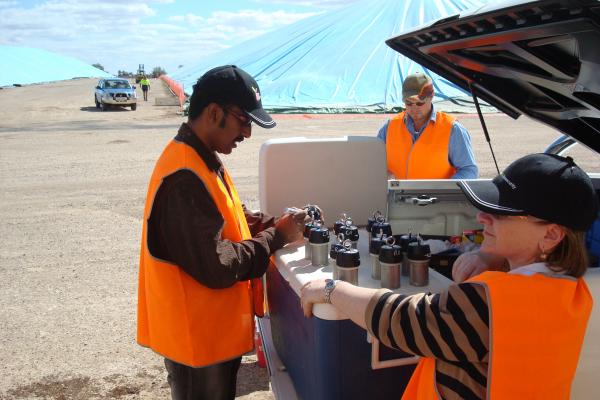
© 2009-2012 CRC for National Plant Biosecurity | Disclaimer
![]()


A range of grain storage pests including beetles, psocids, moths and mites habitually threaten the food safety, market access, trade and the overall profitability and sustainability of the Australian grain industry. Some of these pests have been detected with resistance to phosphine and currently registered contact insecticides (grain protectants) and the spread of resistance is on the rise annually.
The project has been completed with all project milestones achieved on time. During 2007-08, a total of 632 insect samples collected from 115 farms and 150 bulk storages were tested for resistance to phosphine and key grain protectants. The insects comprised of the major pest species: lesser grain borers, flat grain beetles, rice weevils, rust-red flour beetles, saw-toothed grain beetles, psocids and moths. The overall result suggest that the development of resistance to the currently registered grain protectants and fumigant phosphine is a serious issue threatening the profitability and market access of our grain industry.
While the overall frequency of weak resistance to phosphine remained high in lesser grain borers, rust-red flour beetles and rice weevils, the detection of strong resistance in several populations of flat grain beetles has become the emergence resistance issue. This resistance has also been detected by the collaborating researchers in the Southern region (NSWDPI, led by Dr Joanne Holloway). The level of this resistance is high and in response the CRCNPB has initiated a project titled 'Fumigation protocols for the strongly phosphine resistant flat grain beetles' [1]in consultation with end users.
Among the key grain protectants tested, fenitrothion was found to control all strains of rust-red flour beetle, rice weevil and flat grain beetle without any resistance, whereas 60-80% of strains of lesser grain borer were detected with resistance to deltamethrin and s-methoprene. The industry is waiting for the registration of spinosad which will be used particularly to control resistant lesser grain borers.
The evolution of resistance to phosphine and key contact insecticides for the post-harvest protection of grain seriously jeopardises market access for Australian product. There is a need for both strategic and tactical information on the presence/absence and trends in resistance to phosphine and key contact insecticides to underpin resistance management in the grain industry.
Grain growers, bulk handlers, merchants, food processors, flour millers, maltsters, lot feeders and cereal manufacturers.
The research team expresses sincere thanks to the managers and field staff of GrainCorp for their support and help for accessing storage sites for collection of insect samples.


Resistance in grain storage insects to chemical treatments continues to be a problem throughout the southern region. Regional surveys have detected new sites of strong phosphine resistance, with only a few recurrences at previous sites (generally central storages).
High levels of resistance to phosphine were detected in the flat grain beetle and lesser grain borer in the southern region.
The regional surveys found new sites of strong phosphine resistance which tended to be associated with the storage of grain in unsealed structures.
Levels of resistance to phosphine now being detected in flat grain beetles cannot be controlled with current protocols and threaten management of this insect both on farm and in central storages. This will place increasing pressure on protectant insecticides such as methoprene and deltamethrin and further control failures are predicted throughout NSW, Victoria and South Australia.
If resistance to phosphine continues to develop at the rate recently detected in the flat grain beetle, then alternative chemical treatment will be required.
Furthermore, recent changes to the phosphine label state that it is restricted to use in “well-sealed structures” which will further limit accessibility as many farms do not have these structures.
Any new chemical treatments that may be developed will invariably be more expensive than phosphine and are also likely to require added infrastructure costs for application.
However without alternative treatments it is probable that further control failures will occur which will place increasing pressure on the ability of Australia to maintain competitive advantage based on insect-free grain.
To prolong the use of phosphine in the interim period it is recommended that an education and training program be developed for the use and application of phosphine.
This will assist the grain storage industry with an understanding of appropriate and optimal chemical application and fumigation procedures.
The NSW Department of Primary Industries would like to acknowledge the following organisations for supporting the project:
Links:
[1] http://www.crcplantbiosecurity.com.au/program/post-harvest-integrity/project/crc50098-fumigation-protocols-flat-grain-beetles
[2] mailto:manoj.nayak@deedi.qld.gov.au
[3] http://legacy.crcplantbiosecurity.com.au/content/nayak
[4] http://legacy.crcplantbiosecurity.com.au/program/surveillance
[5] http://www.graincorp.com.au/Pages/default.aspx
[6] http://www.industry.nsw.gov.au/
[7] http://www.dpi.qld.gov.au/cps/rde/dpi/hs.xsl/home_ENA_HTML.htm
[8] mailto:joanne.holloway@industry.nsw.gov.au
[9] http://legacy.crcplantbiosecurity.com.au/content/holloway
[10] http://www.grdc.com.au/
[11] http://www.viterra.com.au